For every project a company pursues, those in charge want to ensure it generates a return on investment. Before you launch into a new venture, it’s essential to complete a feasibility study.
Feasibility studies help to determine the success (or failure) of your proposed project or plan. These types of studies help you make better, informed business decisions. As a result, you can save time and money by starting a plan or a project that you know has a high ROI.
In this post, I’ll share the importance of feasibility studies, the different types, and some effective feasibility studies examples I found.
Download Now: Free Business Startup Kit
Table of Contents
- What is a feasibility study?
- What are the advantages of conducting a feasibility study?
- Types of Feasibility Studies
- Feasibility Study Template
- How to Write a Feasibility Study
- Feasibility Study Examples
What is a feasibility study?
A feasibility study analyzes a potential project’s benefits, risks, costs, and potential outcomes. After completing a feasibility study, you and your team will have enough information to determine if the proposed project is a worthy investment.
There are two types of sales forecasting data that are appropriate for feasibility studies:
- Quantitative forecasting data. Uses historical business data to predict trends.
- Qualitative sales forecasting data. Takes customers’ opinions, market research, and survey results into account.
The type of feasibility study you run determines which type of data you will need. Consider using qualitative forecasting data to determine how well your audience might receive your product. Quantitative data can help you predict revenue.

Free Business Startup Kit
9 templates to help you brainstorm a business name, develop your business plan, and pitch your idea to investors.
- Business Name Brainstorming Workbook
- Business Plan Template
- Business Startup Cost Calculator
- And more!
Download Free
All fields are required.

What are the advantages of conducting a feasibility study?
As a team leader, it’s your job to ensure your team hits yearly sales revenue goals. That may include deciding to take on a project based on projected sales forecasting data.
However, you do not want to take on a proposed plan or project without being sure the project will benefit your organization. Companies with accurate forecasts are 10% more likely to increase revenue yearly, according to Argano.
That’s why feasibility studies matter. When you combine sales forecasting data with the insight from a feasibility report, you’ll be able to gauge the success rate of your proposed plan before you start.
I was curious to find out what specific insights can come from a feasibility study, so I asked the experts. Here’s what industry leaders say are the advantages of conducting a feasibility study.
Helps you identify new opportunities.
Sidharth Ramsinghaney, Director of Corporate Strategy and Operations at Twilio, suggests that a feasibility study isn’t just a matter of forecasting but can also help companies identify opportunities.
“In my experience leading Fortune 100 transformations, feasibility studies are invaluable strategic tools that go beyond simple go/no-go decisions,” says Ramsinghaney. “They reveal hidden opportunities and risks that aren't apparent in initial strategic discussions, essentially serving as an early warning system for major investments.”
Prevents wasted resources.
Michael Taylor, the CEO and Co-Founder of SchellingPoint, an applied research organization specializing in group decision-making, suggests that feasibility studies can prevent teams from spending unnecessary resources.
“Feasibility studies help companies understand before investments of time or money are made and before action is taken, how many of the goals will be realized, why they can't be, where the sensitivity points exist, and other considerations that allow the implementation plan to have the greatest likelihood of success,” he said.
Provides confidence.
Taylor also shared an intangible benefit of a successful feasibility study. “Decision makers can move into implementation confident their use of scarce company resources will produce a worthwhile ROI, and they and their team can be successful beyond the plan looking rational and logical,” he says.
Other feasibility benefits include:
- Determining if the project is appropriate for your team.
- Making sound decisions for your team.
- Avoiding mistakes.
- Narrowing the focus of the project.
- Determining project and team needs.
- Determining which departments need to be involved in the project.
- Calculating the amount and source of appropriate funding.
- Assessing the success or failure rate of your project.
- Estimating ROI.
Not only do feasibility studies help determine if a proposed plan or project is viable, but they also help narrow the focus of the project. Overall, feasibility studies can help keep your project on track from the start.

Free Business Startup Kit
9 templates to help you brainstorm a business name, develop your business plan, and pitch your idea to investors.
- Business Name Brainstorming Workbook
- Business Plan Template
- Business Startup Cost Calculator
- And more!
Download Free
All fields are required.

Types of Feasibility Studies
Now that you understand the benefits of feasibility studies, I want to break down the different types, so you know which kind of feasibility study is best for your team.
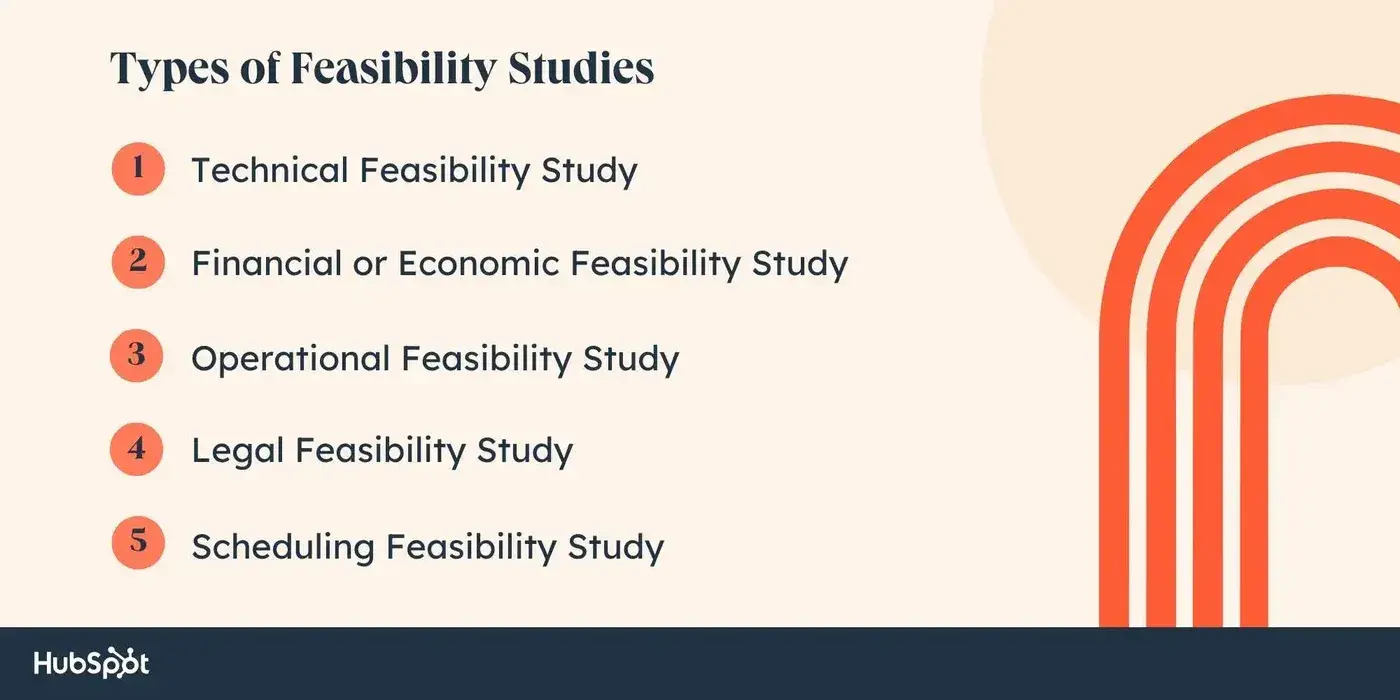
Technical Feasibility Study
A technical feasibility study looks at your project’s technical aspects. This type of study answers the question: do you have the specialized resources and capabilities to carry out this project?
You might have the appropriate funding for a project, but a technical feasibility study will help you determine if you have the right processes, systems, and staffing for the job.
Best for: Software development teams and project development teams.
Financial or Economic Feasibility Study
Financial feasibility studies can help you determine if you have the funding for your project. You’ll also learn whether or not the venture is an overall good investment for your team and your company. These kinds of feasibility studies ask: is the allotted funding amount appropriate for this project?
By completing a financial feasibility study, you’ll have already identified funding sources, expenses, your budget, any potential risks, and expected revenue.
Best for: In my opinion, this type of study benefits not just financial managers but also project managers since they oversee the budget.
Operational Feasibility Study
As the name suggests, an operational feasibility study analyzes whether or not your team is equipped to carry out the proposed plan or project. This feasibility study answers the following questions:
- Does your team have the means to complete the project?
- Will the project add value for your team or your customers?
I recommend conducting an operational feasibility study if you have developed a solution for a potential problem. This kind of study will help you determine if the solution solves the problem or creates more issues.
Best for: Project managers and stakeholders.
Legal Feasibility Study
This feasibility study should be performed to determine if your proposed project is legal and ethical. Legal feasibility studies are designed to keep you and your team aligned with local, state, and federal laws.
If you are unsure if your project is unethical or unlawful, a legal feasibility study will help you make the appropriate decision before you begin.
Best for: I recommend both legal departments and project managers be involved in a legal feasibility study.
Scheduling Feasibility Study
Anytime I start a new project, I’m often asked by clients, “When can we reasonably expect this project to be completed?”
If you and your team are working for clients and are on a deadline, a scheduling feasibility study looks at the project’s timeline. That can help your team determine a reasonable completion date.
After completing a scheduling feasibility study, you might find the plan requires more time than you thought. This is helpful to know before you begin a project.
Best for: In my opinion, key stakeholders and project managers should be involved in this type of feasibility study.
Feasibility Study Template
If you’re like me, you prefer to use templates when conducting a new strategy or approach for the first time. There’s something about using the guidance of a template that feels more approachable than starting from a blank page.
Look no further than HubSpot’s feasibility study template. The template is one of nine templates included in the free business startup kit — an essential resource for any startup.
What I like best about this feasibility study template is that it can be customized to fit the needs of you and your team.
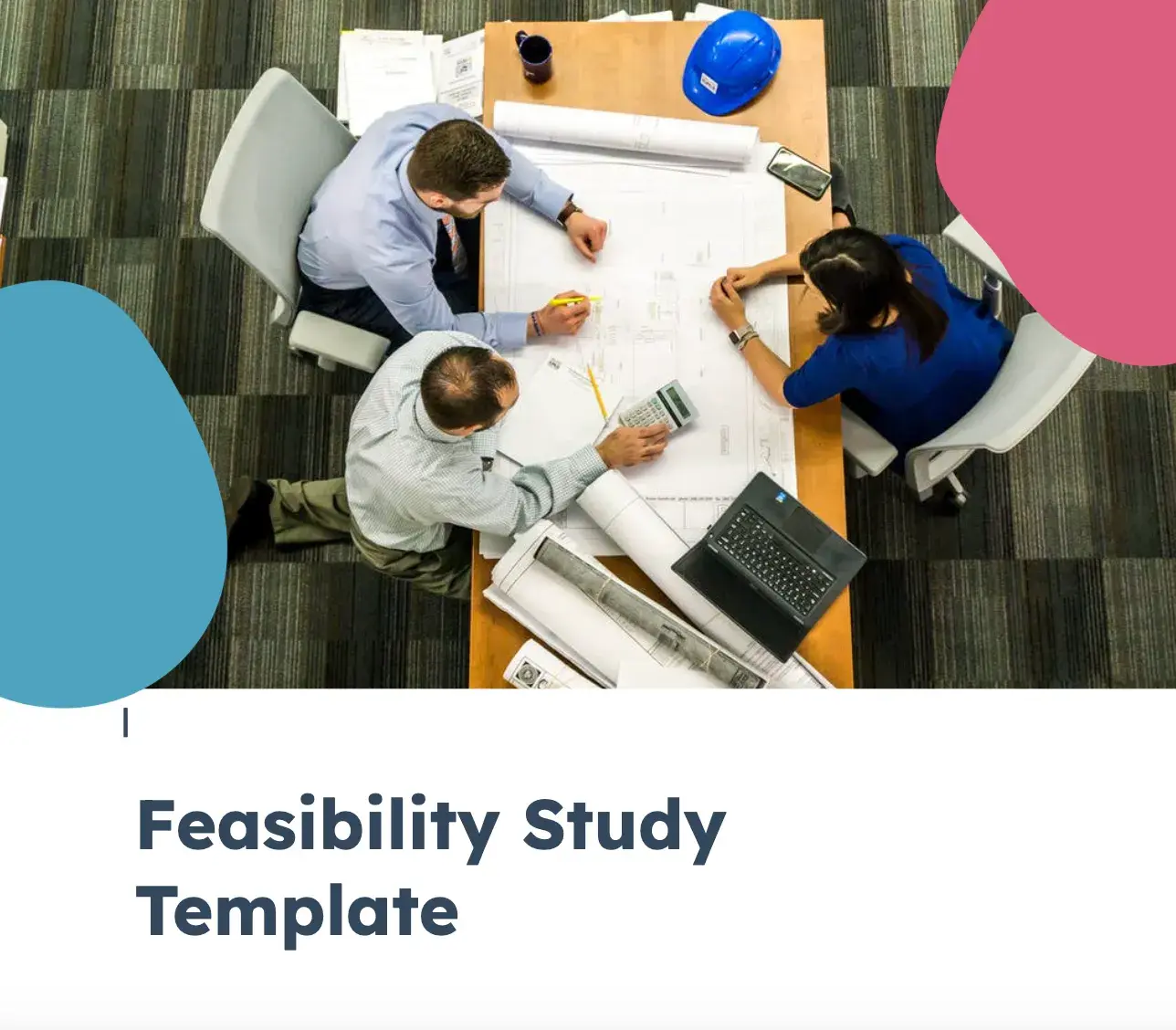
Before you jump into writing your feasibility study using this template, I want to go over each section of the template so you know exactly how to use it.
How to Write a Feasibility Study
Use HubSpot’s free feasibility study template and follow these steps to conduct your own study.
1. Executive Summary
Your executive summary should be a one-page summary of the entire study. Make sure to include the following:
- The project name.
- A description of the project.
- The goals of the project or plan.
- The target market.
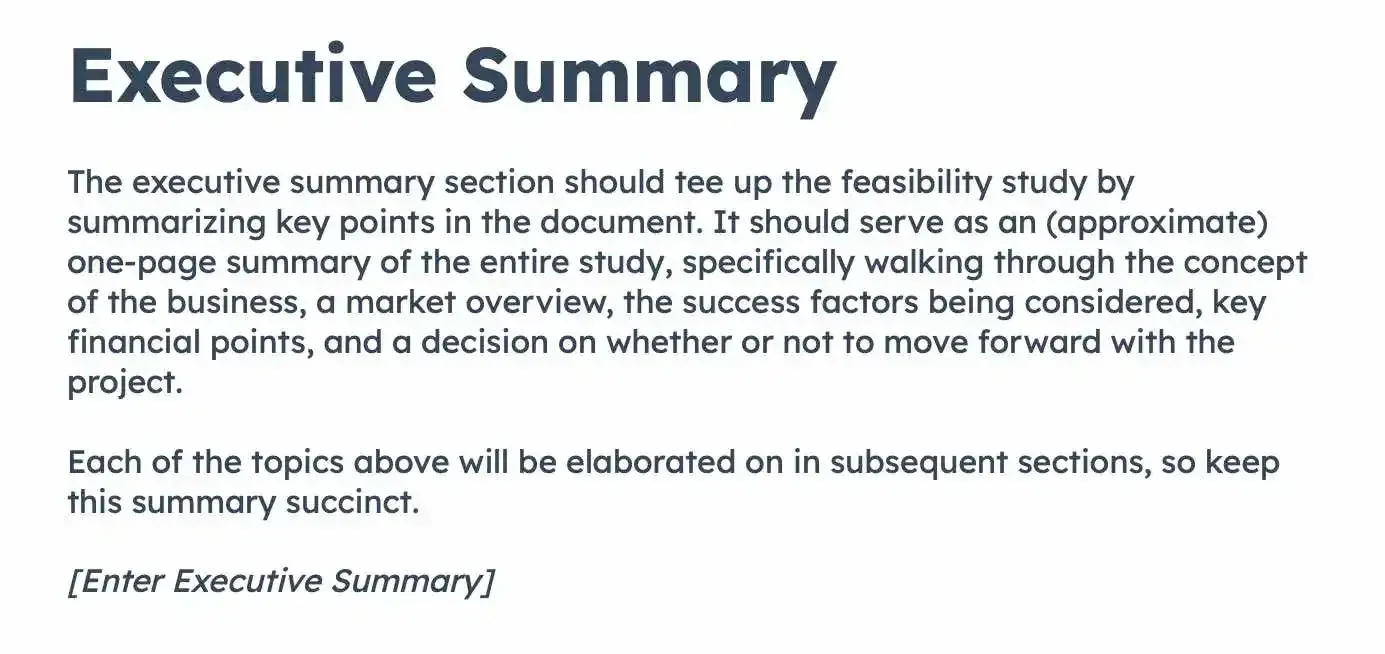
2. Business Explanation
This section of the feasibility study is your space to introduce the business concept of your project or plan. Consider discussing:
- The purpose of the project or plan.
- Products or services.
- Competitive advantages.
- Experience of its founders.
If your project is feasible, you’ll want to be as specific as possible in this section and discuss the project’s projected success.
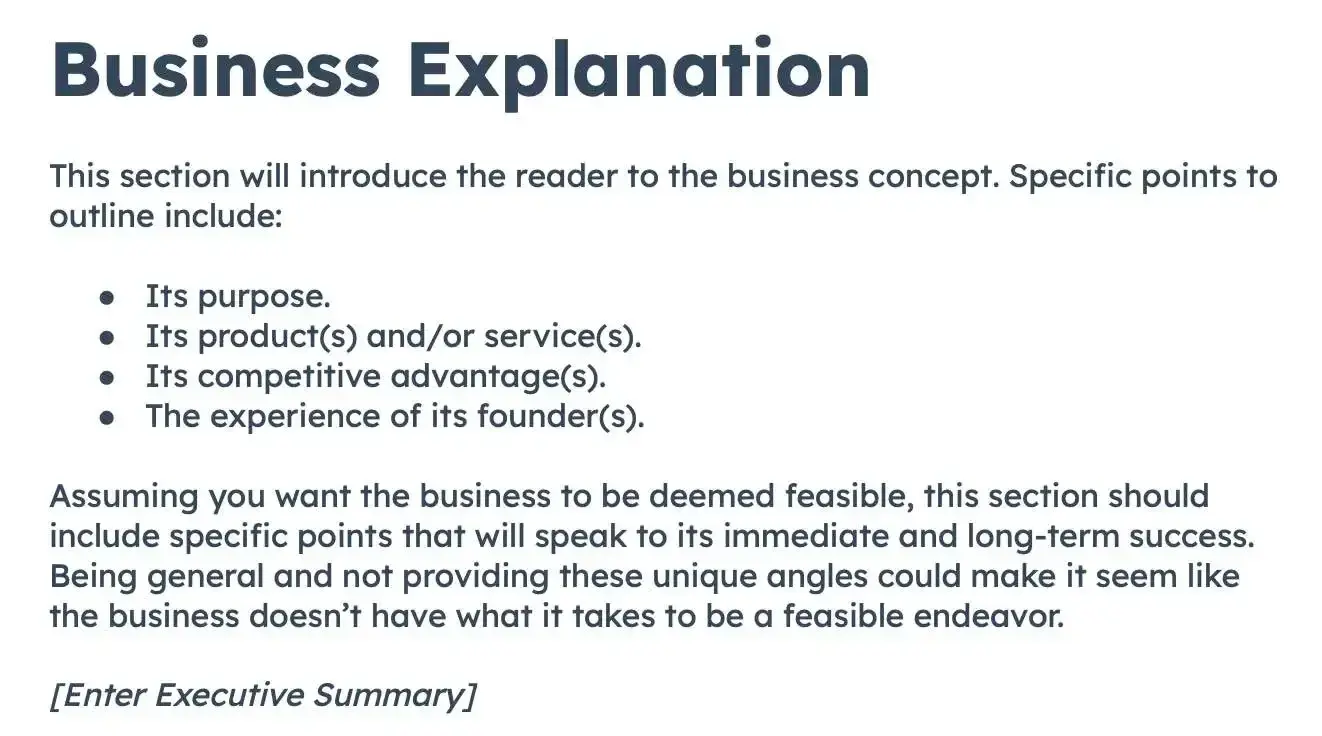
3. Market Overview
This section of your feasibility study should discuss your target market and why your project or plan will (or will not) succeed. You’ll want to discuss your target market in-depth, its pain points, and how your proposed product or service will solve the problems.
You’ll want to include valid data in this section. Consider featuring:
- The market size and demographics.
- The market psychographics.
- Competitors and substitutes.
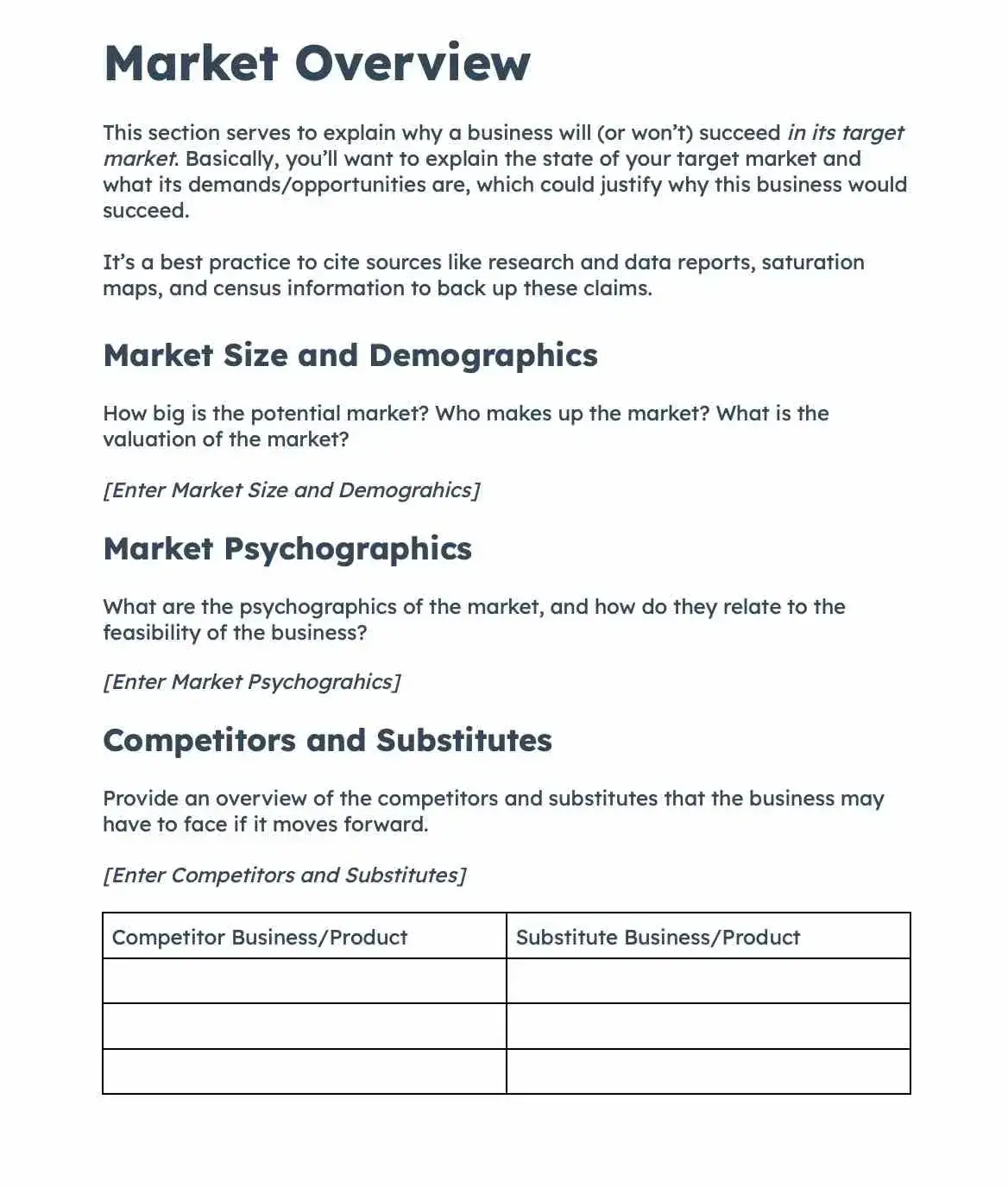
4. Financial Projections
Every good business endeavor is meant to make a profit. Your feasibility study should determine if the project or plan is a financially wise investment. The financial projections section of the feasibility template outlines and discusses critical financial metrics.
Considering including and discussing:
- Capital needs.
- Projected revenue and expenses.
- Projected revenue needed to break even.
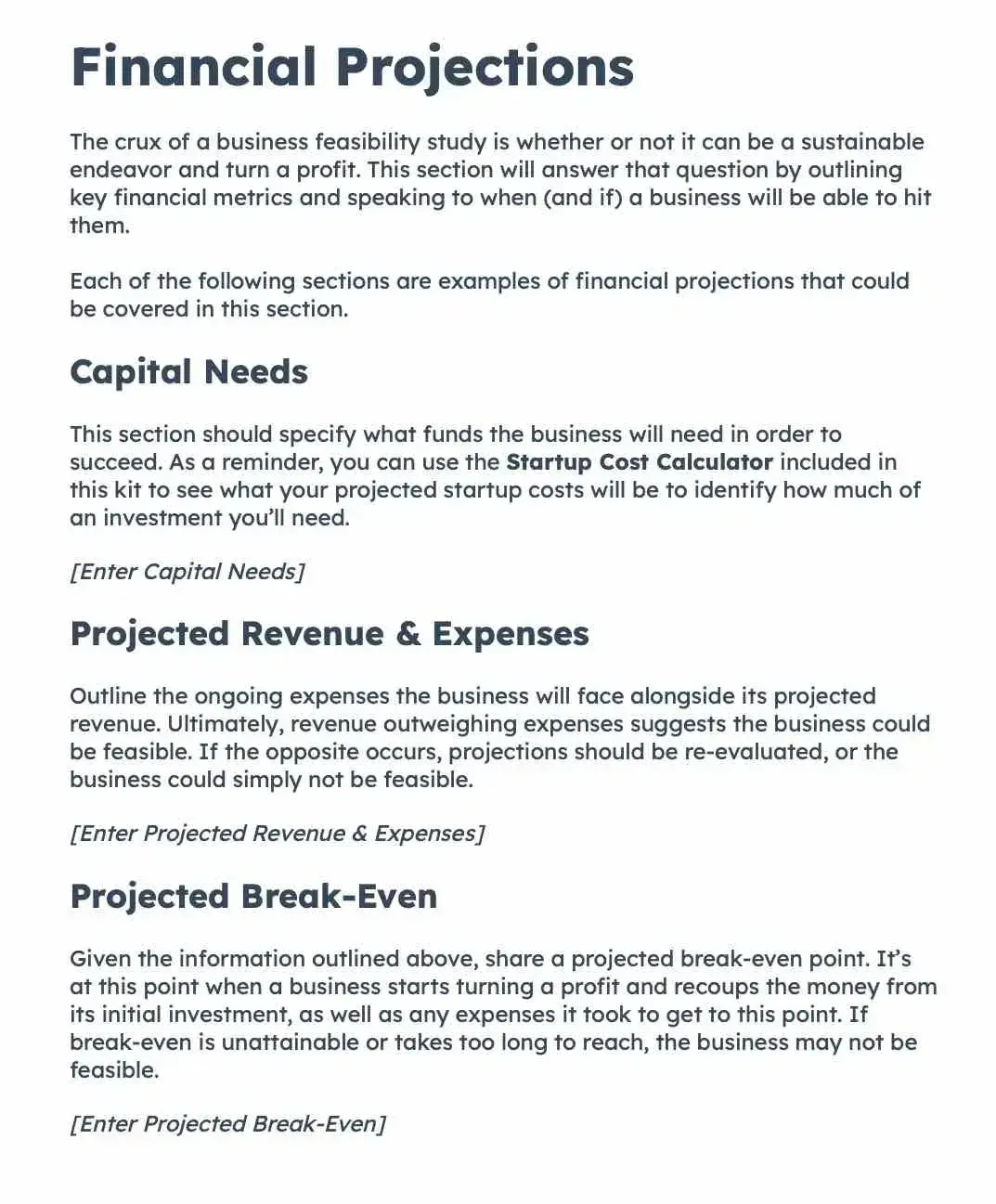
5. Feasibility Assessment and Conclusion
In your conclusion, be as clear and specific about your proposed project or plan as possible. Use statements like, “Based on our assessment of (X), we have deemed this business project feasible.” It’s also a good idea to include your proposed next steps so readers know what to expect going forward.
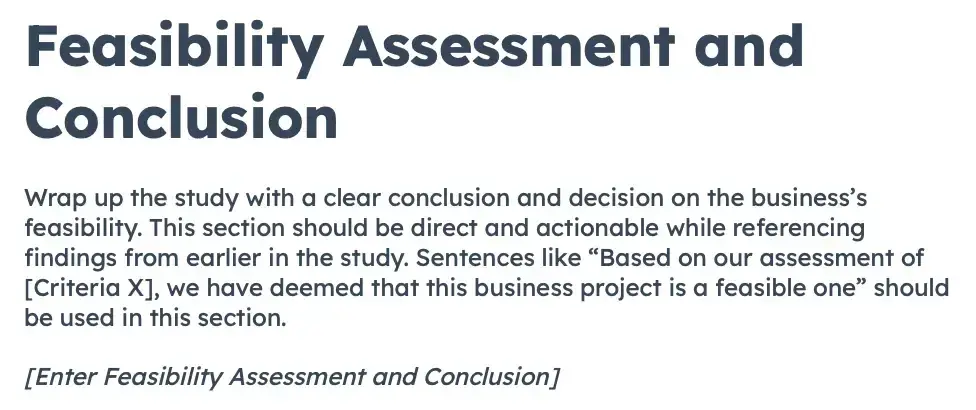
Feasibility Study Examples
Feasibility studies can be helpful across different industries and even your entire organization — from the sales team to the product development team.
To help you see the impact of a feasibility study, I’ll break down a few examples of feasibility studies conducted in various industries.
1. Marin Municipal Water District
Marin Water Municipal Water District conducted a general feasibility study to evaluate its facilities, services, and programs. While the organization shared a general vision, it also used this study to focus specifically on recreation management along one of its watersheds.
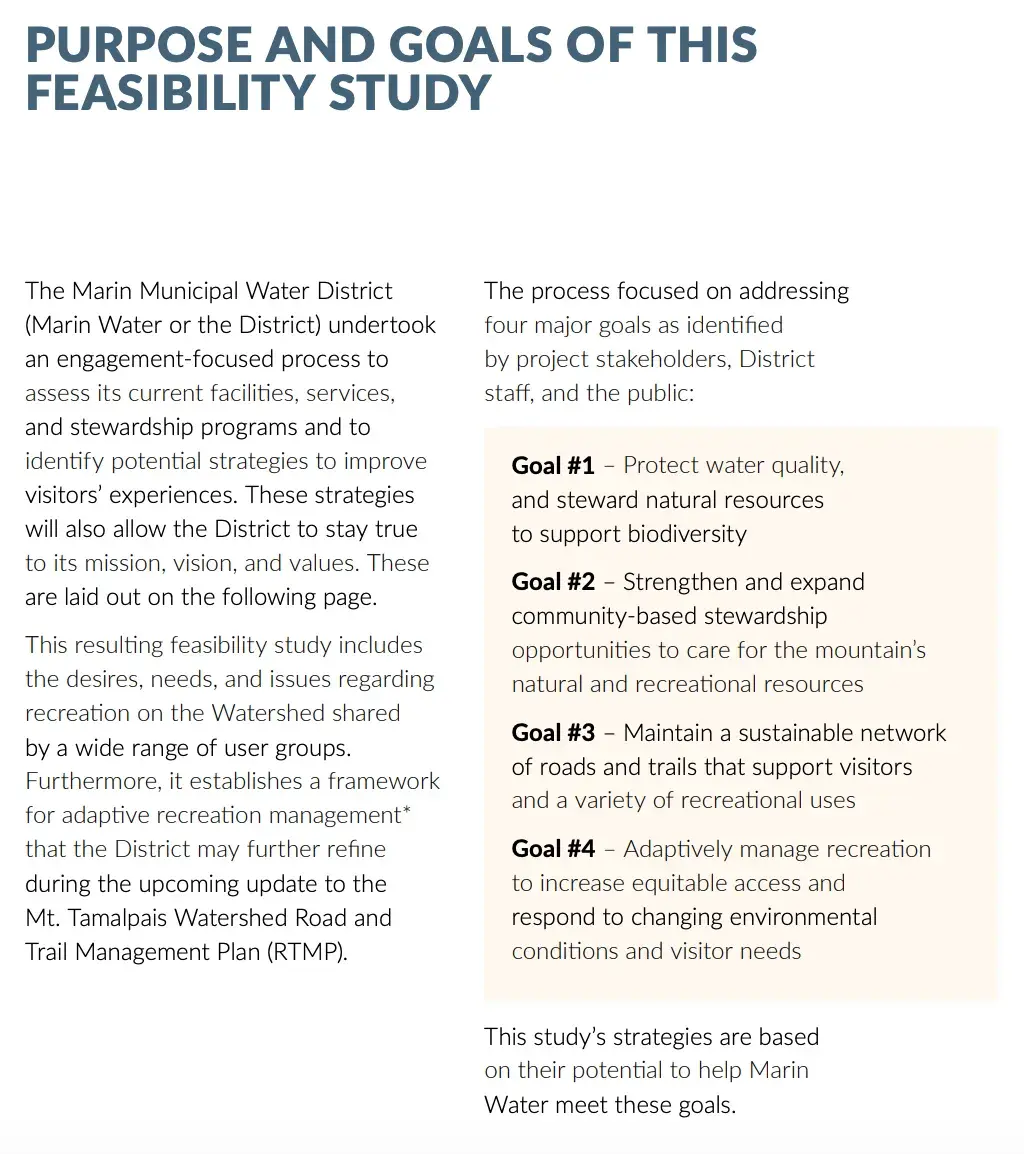
What I love most about this feasibility study is the fact that the organization relied heavily on public opinion and engagement to inform its goals and decisions. Marin Water outlined its engagement efforts before completing the study, which included:
- Six community workshops
- Two site visits
- Over 20 interviews with stakeholder groups
- Individual interviews with park rangers
- AWatershed-wide visitor survey
What I love: This level of community engagement and participation is valuable for a public resource. I’m impressed at the actions taken by the organization and even more impressed with how those actions are outlined in this feasibility study.
2. U.S. Fish and Wildlife Service (USFWS)
In this example, the U.S. Fish and Wildlife Service explores the feasibility of reintroducing sea otters to areas of the Pacific coast. I found this study interesting because it addresses multiple feasibility categories that are unique to its needs. The study breaks down the biological, socioeconomic, and legal feasibility of its species reintroduction plan.
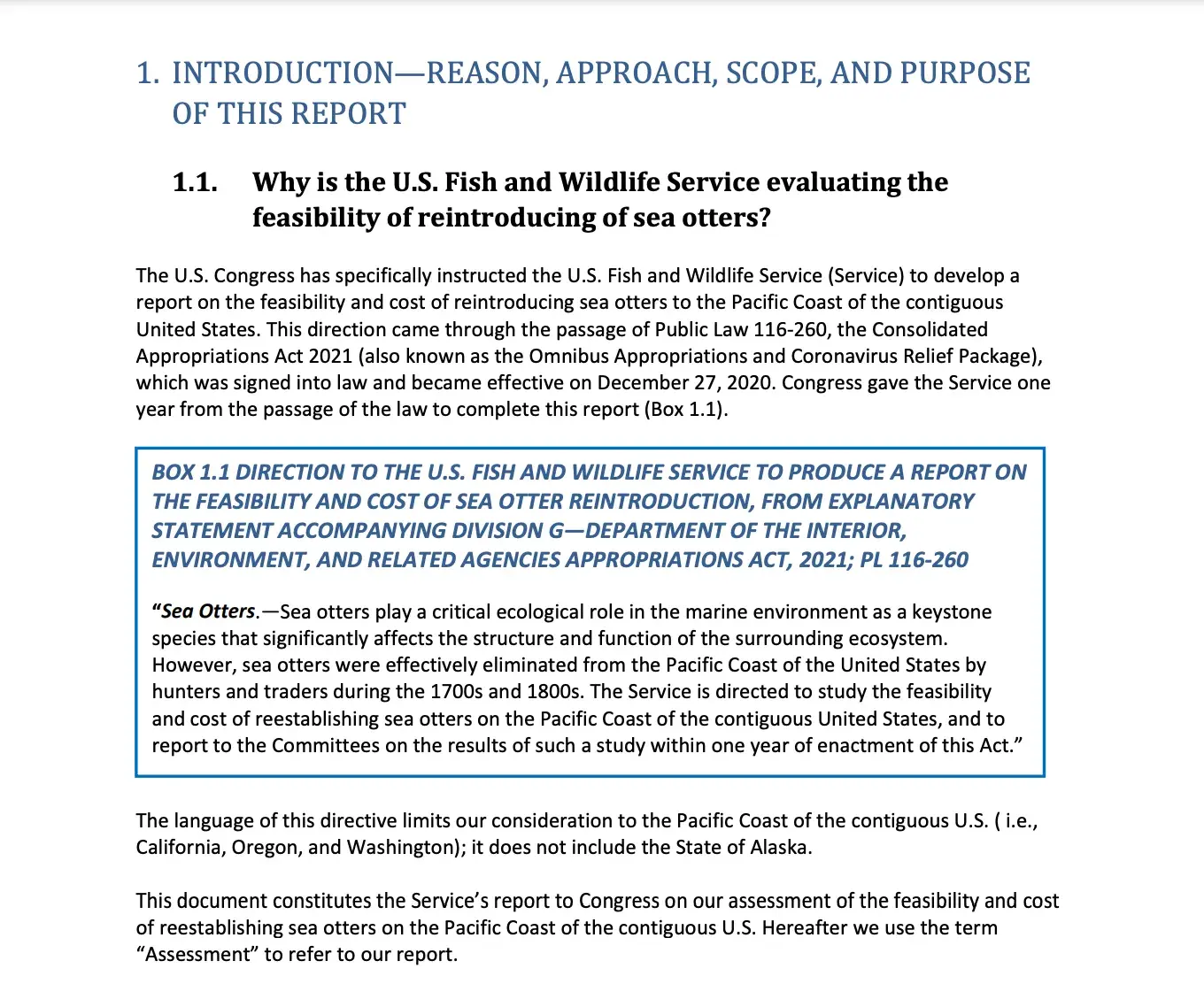
Here’s what’s covered in the full study:
- An introduction to the reason, scope, and purpose of the report.
- The history and background of the sea otter population and past reintroduction attempts.
- A feasibility assessment of biological, socioeconomic, and legal feasibilities.
- Estimated costs involved in the reintroduction program.
- A full risk assessment.
- An outline of recommendations and next steps.
Another strength of this feasibility study is that it provides a solid model for how to structure a comprehensive study, especially when addressing multiple feasibilities. I’d recommend taking a look at the full document to see how informational it is.
What I love: The U.S. Fish and Wildlife Service distinguishes what the study covers (potential options for reintroduction) and what it cannot accomplish (projected population growth from reintroduction).
3. Westmass Area Development Corporation
In this feasibility study, a development company created a feasibility study for the town of Northfield, Massachusetts. The study was created to assess the viability of developing a business park in the town.
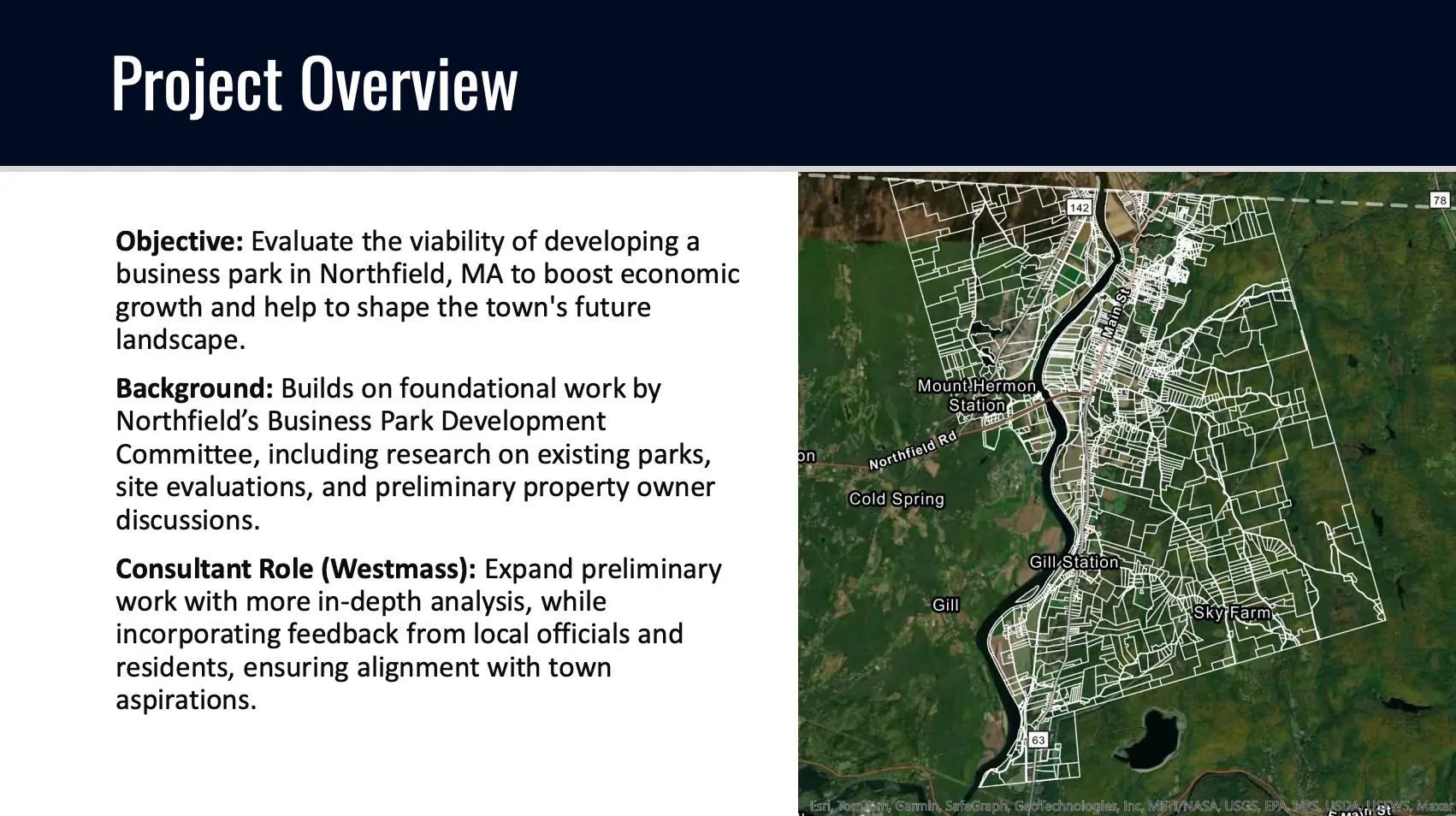
While the study is brief and presented in succinct, easy-to-read slides, it also shares comprehensive information. The study includes:
- Site feasibility analysis
- Market opportunities
- Financial, legal, and regulatory considerations
What I love: Images and graphs are easy to read. You can absorb important information with a quick skim. If you want to incorporate more imagery into your feasibility study, I’d recommend using infographics and avoiding generic stock images that don’t add value to the report.
What I Learned About Running a Feasibility Study
Accurately predicting the success of a project might seem like a daunting task. But it doesn’t have to be. After reading through the feasibility studies I shared above, I learned that there are many ways to conduct a feasibility study.
There isn’t a one-size-fits-all formula. Sure, there are helpful feasibility study templates and suggested structures to follow. However, how you approach your feasibility study and what you include in the report are unique to your project’s needs and goals.
Start by leveraging the tools you already have, like HubSpot’s Forecasting Software and the free feasibility study template. With the use of sales forecasting data and feasibility studies, you’ll be able to pursue the projects that will yield the highest ROI.

Free Business Startup Kit
9 templates to help you brainstorm a business name, develop your business plan, and pitch your idea to investors.
- Business Name Brainstorming Workbook
- Business Plan Template
- Business Startup Cost Calculator
- And more!
Download Free
All fields are required.

Business Growth


![How Entrepreneurs Navigated (& Survived) Recessions [New Data & Expert Tips for Economic Slumps]](https://53.fs1.hubspotusercontent-na1.net/hubfs/53/Copy%20of%20Featured%20Image%20Template%20Backgrounds%20(55).png)


![Grants for Black-Owned Businesses and Other Funding Resources for Black Business Owners [+ Deadlines for 2025]](https://53.fs1.hubspotusercontent-na1.net/hubfs/53/copy%20of%20jade%20walters%20btb%20(41).png)

%20(1)-1.png)
![Here's How to Value a Company [With Examples]](https://53.fs1.hubspotusercontent-na1.net/hubfs/53/Value%20a%20Business%20fi%20(1).png)


